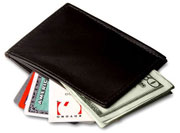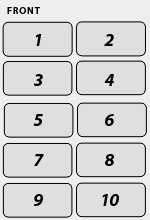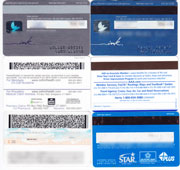What’s in Your Wallet?
Without looking, do you know what's in there? The honest answer has to be, “I’m not 100% sure.”
That’s not good. Wallets go missing and get stolen. When that happens, you need to take immediate and decisive action (see last month’s article: Your Wallet is Gone). That means you need to know—exactly—what was lost and whom to contact. The best way to gather that info with a simple and quick “wallet audit.”
It’s easy to do. So easy and quick that you should commit to yourself that you'll create one today.
Here are the steps:
WALLET AUDIT PROCEDURE
1. Take everything out of your wallet.
2. Group your credit cards, store cards, library card, medical insurance card, ATM card, driver’s license, etc. (Now is a good time to slim down your wallet by removing expired and infrequently-used cards, old receipts, and the like).
3. Go over to the copy machine (or better yet, a flat-bed scanner if you have one), and lay out your cards on the glass platen, front side down in two columns of up to five cards each.
4. Make a copy or scan.
5. Examine it. Make sure the embossed numbers are legible. If not, you can take a magic marker or sharpie and rub it lightly on the raised numbers, then repeat the copy/scan.
6. Flip the cards over to copy the back side. Also swap the cards left-for-right. That way, they’ll appear in the same order as the front page.
 
7. Make the back side copy or scan. Extra points if you feed the front side paper back in the machine/printer so that it becomes an actual front & back copy.
8. Examine the image. Make sure all important info is legible, especially the customer service telephone numbers. If not, mark up your copy with a pen.
9. Write today’s date on the page.
|
You’re done:
 
Now that you’ve completed your wallet audit, what do you do with it?
- Make/print several copies.
- Give one to a trusted assistant, friend, or family member.
- Keep one in a secure location at home, and another at the office.
- When traveling, put one in a secret location in your luggage (hint: zip open the inner lining and tape it to the shell of your suitcase).
- Fold one up and keep it with your passport.
- Make a scan and upload your image files to Dropbox or other secure cloud location, so you can access the info from anywhere you can get online.
Next, get out your calendar and write a reminder to do this again near the end of the year. Better yet, put an automatically recurring reminder every 6 months in your Outlook or Google calendar. In a perfect world, you'd update your audit every time you get a new card, but we both know that's probably not going to happen. At least this way, with semi-yearly reminders, you'll never be too far away from current.
If you don’t have access to a copier or a scanner, take a photo with your smartphone or digital (not film) camera instead. However, if you do keep the photo on your phone, be sure to set a password or swipe pattern so your card numbers don’t fall into the wrong hands if it’s lost. (This is good advice in general.)
Of course, if your wallet never goes missing, this exercise will have been for nothing. But if it’s ever lost or stolen, you will be very, very happy you took the 10 minutes to follow this simple advice.

Return to Archive |





